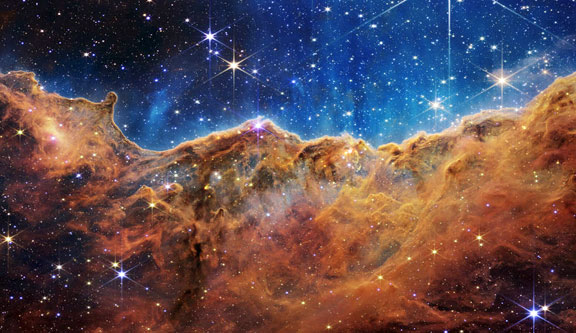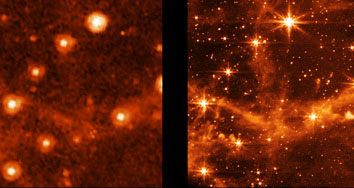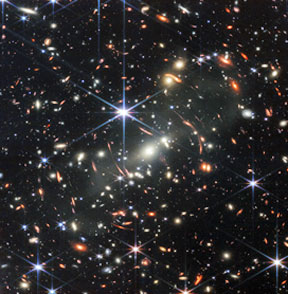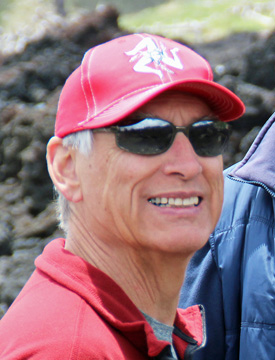|

Image in infrared light by NASA’s new James Webb Space Telescope, revealing previously invisible areas of star birth.
On
July 13, NASA published its official review of the performance of its
new James Webb Space Telescope (JWST) after 6 months of commissioning:
positioning, alignment, calibration, and testing.
Conclusion: JWST exceeds every significant design goal.
JWST
has demonstrated the sensitivity, stability, image quality, and
spectral range (span of light wavelengths) to achieve its design goals
of enabling “fundamental breakthroughs in our understanding of the
formation and evolution of galaxies, stars, and planetary systems”.
JWST’s demonstrated performance exceeds expectations in:
· precise alignment of its 18 main-mirror segments,
· image resolution (seeing fine detail), stability over time
· and pointing accuracy (keeping targets centered during long exposures).
Precisely
executed launch and navigation to its destination, orbiting L2, saved
enough fuel to extend JWST’s useful life to 20 years, twice its design
goal.
L2
is the second Lagrange point of Earth’s orbit around the Sun. A
satellite at L2 orbits the Sun in lockstep with Earth, maintaining a
constant distance of about 1 million miles. The Sun, Earth, and L2
always lie on a straight line.
JWST
excels at imaging infrared light, and can therefore see “deeper”
(farther away and closer to the beginning of time) than can visible
light telescopes like Hubble. Infrared light has much longer wavelength
and much lower energy than visible light, so JWST must operate at very
low temperatures. This is extremely challenging in outer space, where
it’s almost impossible to dissipate heat.
JWST’s
elaborate 5-layer sunshield meets that challenge. The primary mirror
operates at 45K (45 Kelvin or –380ºF). The secondary mirror is at 29K
(–407ºF), and the infrared imager (MIRI) is at 6.4K (–448ºF). JWST’s temperature stability is outstanding — the telescope varies only ±0.04K, and the imaging instruments vary only ±0.01K.
These
infrared images of part of a nearby galaxy compare the JWST (right) to
NASA’s previously best infrared space telescope, Spitzer at its prime
(left).

At
launch, JWST had 344 single-point failure risks — if any one of 344
components failed, the whole mission was doomed, no “plan B”. Now, 295
of these critical components have performed properly and are no longer
needed. This leaves 49 critical components that are still needed, and
must continue to work properly; the radio antenna that transmits image
data back to Earth is one example. It has no backup, but its risk of
failure is deemed very low.
One
unpleasant reality of all space telescopes is being hit by
micrometeriods that are ubiquitous in the Solar System, with numerous
small ones and a few large ones. NASA estimated the primary mirror would
suffer 1 hit per month, and indeed, after 6 months in space, it has
been hit 6 times.
Unfortunately,
one micrometeriod caused about 10 times more damage than the expected
average. NASA hopes that was a fluke and won’t recur often.
The
telescope remains within its design criterion, even after that damage.
Mirror quality is quantified by Wave Front Error (WFE), the average
(“rms”) mirror surface deviation from the perfect shape. The
micrometeriod impact raised JWST’s WFE from 52 to 59 nm (1 nm = 1
billionth of a meter; 59 nm ~ 2 millionth of an inch) The design calls
for WFE less than 70 to 130 nm, depending on the wavelength of light
being imaged.
With great results from over 100 commissioning tests, JWST has begun Cycle 1, its first sequence of scientific observations.
Here is JWST’s first “deep” image, presented on behalf of a proud nation by President Biden.

Hubble
revolutionized our understanding of the universe and our place in the
cosmos. James Webb is its worthy successor, promising new breakthroughs
that will further astonish and amaze.
Best Wishes,
Robert

July, 2022
Note: Previous newsletters can be found on my website.
|